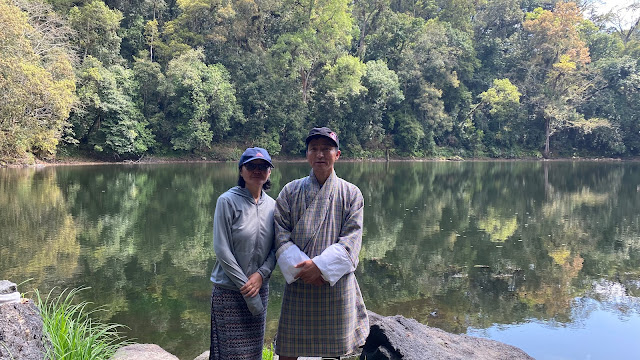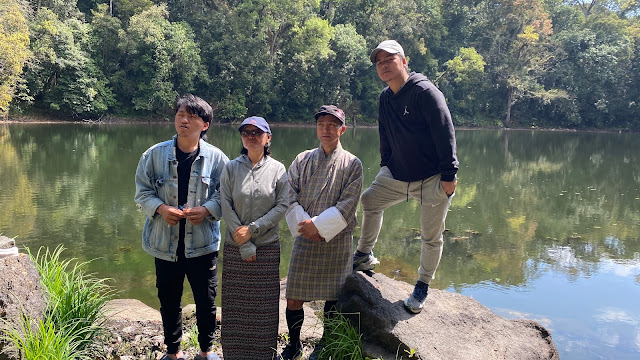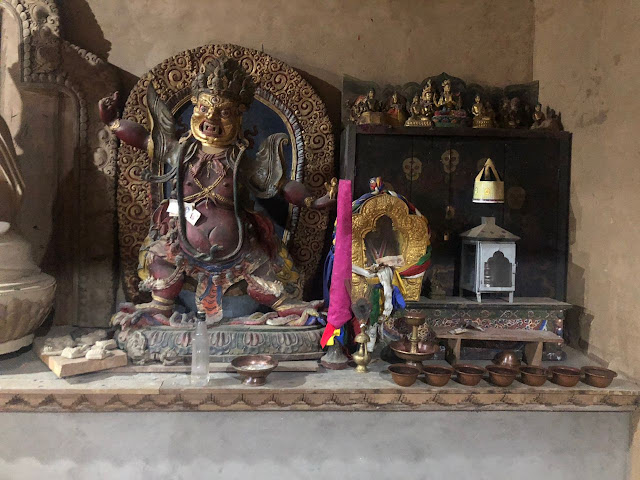A man, adorned in red ropes with curly black hair and a Muslim beard, did not seem particularly enthusiastic in
expressing gratitude for our visit to the site. He mentioned that he was once a teacher but is now a man seeking
solitude. Having spent the last six months at Bjela, he plans to move to Puna Talo next. Without consulting Google about
the temple, I share the words of wisdom conveyed by him during our group discussion on the Birth Anniversary of Guru.
His oral narration was resounding.
The inception of Bjela traces back to the 15th century when Divine Madman's brother, Ngawang Chogyel, started a small
temple. Despite the absence of concrete evidence regarding its size, we were informed about its modest scale through
theoretical understanding and the orientation of small Nangteens (original statues) within the temple. The original
Nangteens, visible in antique forms, include Tempa (Buddha), Tsepamey (Long Life), Guru, Choten, and Ngawang Chogyel.
Before the era of the British East India Company, Bhutan's connections were primarily to the north, encompassing trade
and religious associations. Bjela is intricately associated with Lama Zhabdrung, whose feet many summit.
But how did Bjela get its name?
According to the lama, during Zhabdrung's retreat at Nangsa Lhakhang (near the present-day Paro Town, close to the
vegetable market), guards overheard news of an impending Tibetan war. Concerned for Zhabdrung's safety, they recommended
an immediate move to Thimphu. During the journey, the entourage halted for a night at Bjela. It was here that the
protecting deity of Bhutan, Pal Yeshey Gonpo, appeared to Zhabdrung, assuring him of victory. Zhabdrung praised the
site, considering it sacred. Even if one doesn't have an audience with their Choesung in this lifetime, visiting the
site, praying, and seeking homage is believed to build merits for the next life.
Significant development and restoration occurred in the 60th Je Khenpo Sherab Singye's time, transforming the temple
into its present grandeur. Unique features include a Buddha Statue with Sherab Lha Phakpa Jampelyang (Wisdom) and Nying
Ji Lha Chengrigzee, replacing Sangay’s Khor Sharipo and Morepo. Taba Zhabdrung’s project statue also occupies a
beautiful throne.
The temple's paintings, done on flattened mud walls and restored on cloth pieces, include depictions of Phakpai Neyten
Chudru, Tempa-37 Jangchup Tungsa, Tsepamay Tsophu Nga, Nyewai Tsechi Gyee, and Four Direction Kings. Ngawang Chogyel,
Genyeen, Chana Dorji, Guru, Zhabdrung, and the Yidam are intricately mounted. Choedhu Chorten on the left and Namgay
Chorten on the right enhance the beauty inside.
The Bjela deity, symbolically named Drel-lha, aids communication among travelers and mediates between people or regions.
Despite its physical wrathful appearance, Drel-Lha is believed to be the Speech (Sung) reincarnate of Sangay Kuento
Zangpo.
Observations during our visit revealed a lack of care for the environment, with plastic bottles and wrappers scattered
around. Trees were marked, and rubber bands were tied to leaves for trekking guidance. Rain damaged the uphill road,
making it impassable for anything other than 4WD. A single waste bin was found along the route.
Solutions:
Visitors are encouraged to take responsibility for their waste, and efforts should be made to collect plastic waste.
Agencies promoting Drukpath Trek and RIGGS Phuntsholing are urged to install waste bins. Trekkers should not accept
plastic markings on tree trunks for route guidance but should request environmentally friendly alternatives like chalk
dust, sawdust, colored flour, or degradable papers. Pilgrims are advised to bring offerings like rice or cooking oil for
the Lamas.
How to get to Bjela Dzong:
The smooth road ends at Paro, Ta Dzong, where an uphill farm road diversion leads to the basecamp. Follow the wider road
on the left until reaching the basecamp. Construction is ongoing at the basecamp, and a 4WD vehicle is recommended,
especially during the pouring season. The distance from the base to Bjela measures exactly 5.9 kilometers one way.
Alternatively, there is a farm road access to Bjela from the Tselung Nye road, shortening the travel distance from the
Thimphu side. The altitude is 3614 meters











